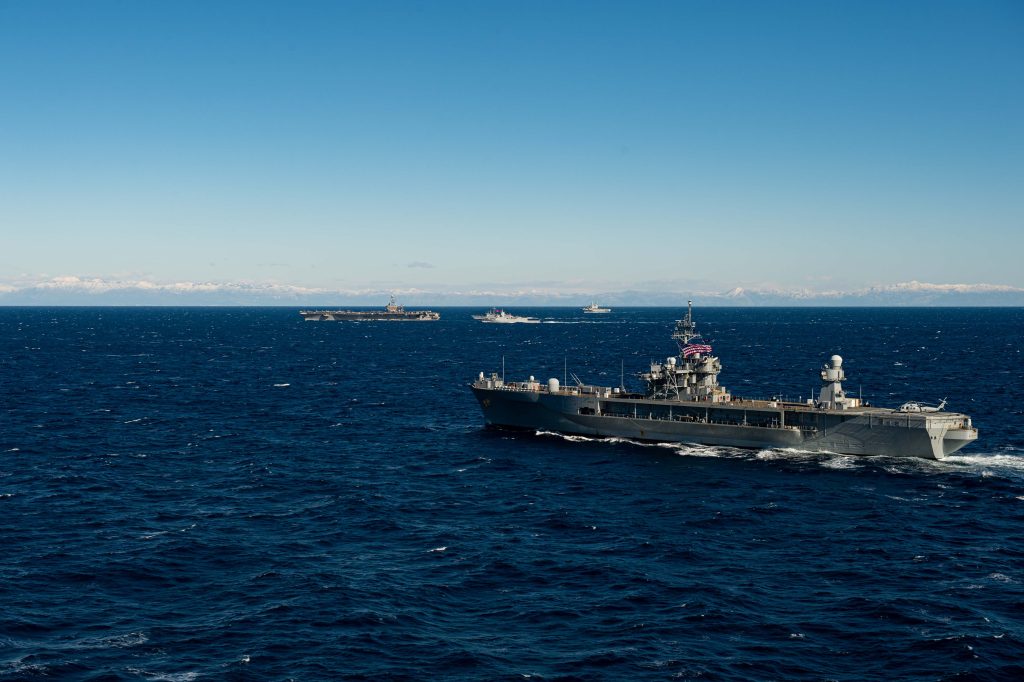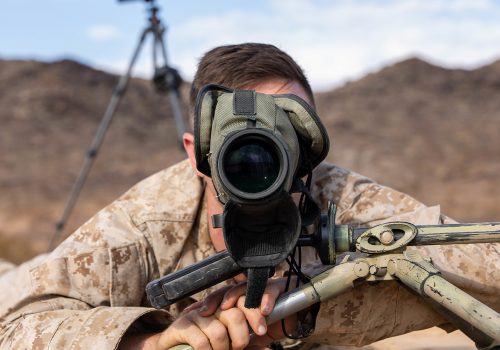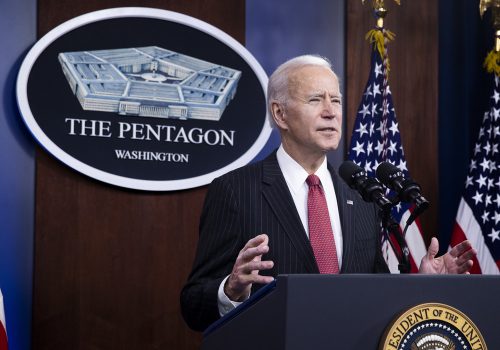The next National Defense Strategy must get Russia right

The rapidly developing 2022 Russo-Ukrainian crisis and ongoing invasion raises a key question for US defense policy makers as they finalize the next National Defense Strategy (NDS): How can the NDS get Russia right? This issue brief seeks to answer this question by developing a US defense strategy for deterring and managing the Russian threat in Europe and beyond, building upon the authors’ 2021 report, Seizing the Advantage: A Vision for the Next US National Defense Strategy. The strategy advances three foundational pillars: 1) countering Russian gray-zone activities and taking the offensive; 2) meaningfully integrating allies and partners; and 3) adopting a more globally oriented force posture model.
Table of contents
Jump to:
Introduction
Priority security goals in Europe
The Russian threat
A new defense strategy for countering Russia in Europe
1. Countering Russian gray zone activities and taking the offensive
2. Meaningfully integrating allies and partners
3. Adopting a more globally oriented force posture model
Conclusion
Introduction
Every US National Defense Strategy (NDS) must grapple with fundamental trade-offs to address the myriad security threats facing the United States and its allies and partners. As the Biden administration prepares to launch the next NDS in early 2022, it is evident that this key document will emphasize strategic competition with China, following the trajectory of the 2017 National Security Strategy (NSS), the 2018 NDS, and the 2021 Interim National Security Strategic Guidance.1The White House, National Security Strategy of the United States of America, December 2017, NSS_BookLayout_FIN_121917.indd (archives.gov); Department of Defense, Summary of the 2018 National Defense Strategy of the United States of America: Sharpening the American Military’s Competitive Edge, January 2018, Summary of the 2018 National Defense Strategy; and the White House, Interim National Security Strategic Guidance, March 2021, NSC-1v2.pdf (whitehouse.gov). Given “strategic simultaneity” among numerous geopolitical and nontraditional threats, including China, Russia, Iran, North Korea, violent extremists, pandemics, and climate change, prioritizing China as the pacing threat is certainly necessary to guide key Department of Defense (DoD) imperatives for force modernization, resource allocation, and alliance coordination.2In their 2021 Atlantic Council report, Seizing the Advantage: A Vision for the Next US National Defense Strategy, the authors define “strategic simultaneity” as the phenomenon of confronting multiple major threats at the same time. In particular, “In a world of intensifying multipolarity among more advanced state and non-state actors, the United States may still be the strongest power by many metrics, but it cannot overwhelm every threat simultaneously.” Consequently, addressing this challenge “requires realistic assessments of critical national and allied interests, the actors and trends that threaten them, and the opportunities for countering them.” For more on this issue, see Clementine G. Starling, Lt Col Tyson K. Wetzel, and Christian S. Trotti, Seizing the Advantage: A Vision for the Next US National Defense Strategy, Atlantic Council, December 2021, 25, Seizing-the-Advantage_A-Vision-for-the-Next-US-National-Defense-Strategy.pdf (atlanticcouncil.org).
However, prevailing policy discourse often neglects Russia as a major revisionist challenger to the international system.3Franco Ordoñez, “The White House wants to focus on China, but Russia continues to be a distraction,” NPR, December 21, 2021, The White House wants to focus on China, but Russia is a distraction : NPR. It would be a mistake for the NDS to inadequately address Russian actions over the past two decades, including the 2008 Russo-Georgian War and the 2014 illegal annexation of Crimea, continuous Russian hybrid attacks (such as cyberattacks, election interference, and influence operations that include disinformation), the ongoing Russo-Ukrainian War in Donbas and beyond, and most recently the 2022 Russo-Ukrainian crisis and now the Russian invasion of Ukraine. While the United States needs to focus on China, Russia continues to pose a grave threat to US interests in Europe.4Starling, Wetzel, and Trotti, Seizing the Advantage, 22; Office of the Director of National Intelligence, Annual Threat Assessment of the US Intelligence Community, April 9, 2021, 9–11, ATA-2021-Unclassified-Report.pdf (dni.gov); and Natalia Zinets and Aleksandar Vasovic, “Russia invades Ukraine in Europe’s ‘darkest hours’ since WWII,” Reuters, February 24, 2022, https://www.reuters.com/world/europe/putin-orders-military-operations-ukraine-demands-kyiv-forces-surrender-2022-02-24/.
Learning lessons from the 2022 Russo-Ukrainian crisis
At the time of publication, after Russia had deployed well over one hundred thousand troops in Belarus and on its border with Ukraine, Russian forces have initiated a large-scale and multi-front offensive into Ukrainian territory. Regardless of the military and geopolitical outcomes of this rapidly developing crisis, the US defense establishment must study Russia’s actions during the crisis and learn critical lessons that can be applied to revising its defense strategy toward Russia.
One example is the evolving Russian way of war. The Kremlin has demonstrated what a future Russian offensive force could look like, consisting of: cyberattacks and influence operations that include mis- and disinformation in the gray zone; a large, mechanized ground force supported by lethal airpower and air defense forces; and a moderately sized surface and subsurface naval fleet. This evolving way of war should inform the United States’ approach to hybrid conflict, integration with allies and partners, and European force posture in the future.
In particular, the ongoing 2022 Russo-Ukrainian crisis raises a key question for US defense policy makers as they finalize the next NDS: How can the NDS get Russia “right”? This issue brief seeks to answer this question by developing a US defense strategy for deterring and managing the Russian threat in Europe and beyond, building upon insights from the authors’ December 2021 report, Seizing the Advantage: A Vision for the Next US National Defense Strategy.5Starling, Wetzel, and Trotti, Seizing the Advantage. The strategy advances three foundational pillars: 1) countering Russian gray-zone activities and taking the offensive; 2) meaningfully integrating allies and partners; and 3) adopting a more globally oriented force posture model. This approach can be implemented regardless of the outcome of the current crisis, but the degree to which it is followed should depend upon the severity of the crisis as it evolves. Moreover, these defense recommendations should be integrated into a broader, coherent NDS that comprehensively addresses the myriad of threats facing the United States and its allies and partners, and they must be paired with an equally robust approach in the NSS that articulates other departments’ roles in the diplomatic, economic, and other elements of this challenge.
Read our Seizing the Advantage report
Priority security goals in Europe
Any strategy must begin with clear goals. This issue brief assumes that US security and defense goals in Europe will remain largely consistent with recent policy and with the overarching vision articulated by US President Joseph R. Biden, Jr., in his administration’s Interim National Security Strategic Guidance—and that they will not change significantly in response to the Russo-Ukrainian crisis.6The White House, Interim National Security Strategic Guidance. The next NDS should continue to prioritize the following goals in Europe:
- Protect and assure the sovereignty and territorial integrity of NATO allies. This means deterring and combating both conventional military threats and hybrid activities below the threshold of armed conflict.
- Safeguard a stable Europe free from aggression. A stable Europe is one in which both NATO and non-NATO countries enjoy secure borders, sovereignty over their respective territory, and economic vitality, thereby setting the conditions for transatlantic peace and trade. Attacks on countries like Ukraine can precipitate major adverse consequences for stability, including refugee migrations and economic devastation, and significantly alter the European status quo, which will require US policy makers to choose between: a) accepting it and deterring further changes; or b) restoring the status quo ante through a compellent approach.7See upcoming analysis from Clementine G. Starling on the strategic crossroads facing NATO following the latest Russia-Ukraine crisis.
- Enhance defense integration with European allies and partners. A strong and unified Europe is a significant deterrent to opportunistic Russian aggression. Accordingly, one key US goal is to enhance peacetime and wartime integration and coordination among NATO allies and non-NATO partners, to include bolstering interoperability, undertaking exercises, and potentially pursuing a “latticed” approach that leverages allied capabilities and encourages allies and partners to work together and with the United States.8Matthew Crouch, Barry Pavel, Clementine G. Starling, and Christian Trotti, A New Strategy for US Global Defense Posture, Atlantic Council, August 2021, A new strategy for US global defense posture – Atlantic Council.
- Maintain access to key geostrategic “high grounds” and choke points that are critical to the United States’ ability to conduct military operations in Europe. This must include improving Baltic Sea regional security; ensuring access to the strategically important Black Sea; preventing Russia from controlling the Greenland, Iceland, and United Kingdom (GIUK) gap in the northern Atlantic Ocean; and securing key physical and digital telecommunications infrastructure, such as undersea cables and satellites.
The Russian threat
The Russian threat is not nearly as comprehensive [as the Chinese threat], but it also transcends multiple elements of national power. Unlike in Beijing, leaders in Moscow recognize that they are not powerful enough to entirely displace the international order, so they instead seek to disrupt it at every viable opportunity, primarily because they perceive the democratic values espoused by that order as an existential threat. Russia expertly manages and employs its limited means.
Starling, Wetzel, and Trotti, Seizing the Advantage, 23.
There is a pervasive perception in the DoD that Russia is a “declining power” relative to the United States and China. Such a perception hampers proactive approaches to the Russian challenge. Russia still maintains both the intention and the capability to significantly disrupt US interests in Europe.9Samuel Charap, “Expanding the Scope for Statecraft in U.S. Russia Policy,” War on the Rocks, May 14, 2021, Expanding the Scope for Statecraft in U.S. Russia Policy – War on the Rocks; National Intelligence Council, Global Trends 2040: A More Contested World, March 2021, 95–96, GlobalTrends_2040.pdf (dni.gov); and Andrew Latham, “Reports of Russia’s decline are greatly exaggerated,” The Hill, December 26, 2021, https://thehill.com/opinion/international/587281-reports-of-russias-decline-are-greatly-exaggerated. The Kremlin values influence in its “near abroad” and perceives democratic systems as an existential threat to its autocratic regime—therefore, it seeks to aggressively interfere with NATO democracies and intervene against its neighbors.10Starling, Wetzel, and Trotti, Seizing the Advantage, 22; and Office of the Director of National Intelligence, Annual Threat Assessment, 9–11. And while Russia is not a near-peer pacing threat like China, the Kremlin understands that it can still opportunistically pursue its objectives through a carefully calibrated toolset. This includes “an ‘escalate-to-deescalate’ nuclear doctrine…a growing arsenal of nonstrategic and exotic nuclear weapons…[and] a variety of hybrid tools such as political warfare, election interference, energy manipulation, mercenaries, and special operations, all of which are designed to divide the NATO alliance and sow fears of escalation among transatlantic states.”11Starling, Wetzel, and Trotti, Seizing the Advantage, 22. As a result, armed conflict with Russia on the European continent has grown increasingly possible, and perhaps more probable than conflict with China in the near term. The United States cannot simply ignore Russia and must continue to balance against both Chinese and Russian revisionism at the same time.12Starling, Wetzel, and Trotti, Seizing the Advantage, 25.
Russian aggression has particularly exacerbated the strategic and operational environment in Europe over the past two decades, holding at risk the four priority security goals outlined above. Thus far, longstanding US commitment to its NATO allies has been successful in deterring conventional Russian military incursions into NATO territory.13Department of State, “The Ironclad U.S. Commitment to NATO,” Office of the Spokesperson, Fact Sheet, November 29, 2021, https://www.state.gov/the-ironclad-u-s-commitment-to-nato/#:~:text=As%20it%20approaches%20its%2073rd,in%20Europe%20and%20North%20America While many non-NATO countries in Russia’s “near abroad,” including Ukraine, Belarus, and Georgia, contain Russian troops, NATO allies’ territorial integrity remains intact.
While this is certainly a success, US goals are at risk in other ways. Russia continues to: violate NATO sovereignty through political warfare, election interference, disinformation, and other hybrid tools below the threshold of conventional conflict; destabilize Europe by occupying and interfering in non-NATO countries; and menace key geostrategic “high grounds” like the Black Sea region.14Office of the Director of National Intelligence, Annual Threat Assessment, 9–11. Although NATO has certainly improved its ability to respond to these challenges since the 2014 illegal annexation of Crimea, these policies have not been sufficient to counter Russia’s evolving hybrid playbook and deter Russian President Vladimir Putin from further aggression.15Charap, “Expanding the Scope.” The 2022 Russo-Ukrainian crisis and invasion will likely precipitate a new and disadvantageous European status quo, and unless the United States recalibrates its defense strategy, it will become increasingly difficult to achieve a more stable European security environment.
Any new defense strategy will need to carefully consider strengths and weaknesses, as the Kremlin will work to circumvent the former and exploit the latter. Fortunately, NATO’s unified response to the 2022 Russo-Ukrainian crisis has been a strength upon which future strategies should build.16Steven Erlanger and Andrew E. Kramer, “In Responses to Russia, U.S. Stands Firm on Who Can Join NATO,” New York Times, February 2, 2022, https://www.nytimes.com/2022/02/02/world/europe/us-nato-response-russia-demands.html; and Steven Erlanger, “Fear of Russia Brings New Purpose and Unity to NATO, Once Again,” New York Times, January 14, 2022, https://www.nytimes.com/2022/01/14/world/europe/nato-russia-ukraine-europe.html. But much of the response since 2014 has been reactive rather than proactive, which is a key weakness as Russia continues to maintain the initiative in this crisis and elsewhere. Therefore, the United States and its NATO allies must undertake a far more proactive approach moving forward.
A new defense strategy for countering Russia in Europe
In pursuit of the four priority security goals outlined above, this issue brief articulates building blocks for how the NDS can get Russia right, including by presenting a different, more interoperable, and more effective combined force in Europe. Drawing upon the authors’ December 2021 Seizing the Advantage report, this issue brief advances the following three pillars.
1) Countering Russian gray-zone activities and taking the offensive
The DoD should be more active in the gray zone, executing offensive and defensive hybrid warfare activities that comport with US values…. These efforts ought to support the greater whole-of-government competition strategy and should be focused on countering malign Chinese and Russian activities.
Starling, Wetzel, and Trotti, Seizing the Advantage, 34.
Why does the United States need to be more active in the “gray zone”?
Russia’s saber-rattling around Ukraine includes numerous gray-zone activities. Among them, Russia has launched a pronounced campaign of influence operations that include mis- and disinformation to paint both Ukraine and NATO as the “true” aggressors of the Russo-Ukrainian crisis. US and UK intelligence have warned of a Russian-planned “false flag” operation to claim a Ukrainian attack on Russia in order to justify an invasion.17Natasha Bertrand and Jeremy Herb, “First on CNN: US intelligence indicates Russia preparing operation to justify invasion of Ukraine,” CNN, January 14, 2022, https://www.cnn.com/2022/01/14/politics/us-intelligence-russia-false-flag/index.html. Suspected Russian-backed and -supported entities have conducted cyberattacks against the Ukrainian government, as well as Norwegian infrastructure.18Agence France-Presse in Kyiv, “Ukraine says evidence points to Russia being behind cyber-attack,” Guardian, January 16, 2022, https://www.theguardian.com/world/2022/jan/16/ukraine-says-evidence-points-to-russia-being-behind-cyber-attack; and JohnJo Devlin, “Russian cyberattacks target Norway’s infrastructure,” Times, January 17, 2022, https://www.thetimes.co.uk/article/russian-cyberattacks-target-norways-infrastructure-mbzhdbz6f. Intimidation tactics have been employed against NATO allies and non-NATO partners alike, such as the suspected Russian drones’ overflight of Swedish nuclear power plants following an increase in Swedish military patrols in the Baltic Sea after the Russian deployment of amphibious warships.19“Swedish police hunt for drone seen flying over Forsmark nuclear plant,” Reuters, January 15, 2022, https://www.reuters.com/world/europe/swedish-police-hunt-drone-seen-flying-over-forsmark-nuclear-plant-2022-01-15/. While major disruptions of Russian natural gas supplies to Europe have not occurred, as of publication, Moscow has reduced its exports to the continent—a concerning tactic against European countries reliant on Russian energy that could have significant domestic consequences and threaten a unified European response.
For the DoD to get its Russia strategy right, the NDS must address the impact that Russia’s gray-zone attacks have on shaping and undermining the European security environment, analyze the military consequences, and evaluate the lessons learned from recent events about the evolving Russian way of war. This requires nothing short of a whole-of-government effort that should be led by the National Security Council and embedded into the NSS. The DoD can play a smaller, supporting role in the gray zone and it should feature in the NDS.
Recommendations for the NDS
For the United States to effectively enhance and shore up security in Europe, the NDS should outline the DoD’s role in deterring, mitigating, responding to, and defending against Russian hybrid threats within its remit, along the following lines:
- Think offensively and develop an engagement strategy for the gray zone. As the authors state in Seizing the Advantage, “Hybrid conflict includes both offense and defense…. The United States should work to favorably shape the cyber, diplomatic, and information environments, and achieve strategic effects against adversaries in the gray zone.”20Starling, Wetzel, and Trotti, Seizing the Advantage, 35. Competing with Russia in the gray zone is about more than just countering influence operations that include mis- and disinformation, and the DoD can take the offensive by executing gray-zone activities of its own. Rather than only responding to attacks once they have happened, the DoD should outline a doctrine for what proactive engagement in the gray zone could look like. This can include: a) an aggressive engagement strategy that promotes transparency and accountability and is oriented toward maintaining credibility in the information environment; b) an avoidance of responding in kind to hybrid threats, in order to not overly pollute the information environment; and c) an accessible playbook that includes thresholds for response depending upon the nature and source of the hybrid attack, as well as a broad range of US response options and tools, in order to maintain flexibility. The military services should also study Russia’s gray-zone tactics in conventional conflict and adapt to its gradualist campaigns in order to better shape the gray-zone environment in their favor.
- Establish a strategic information office within the DoD. The United States should conduct strategic messaging and defensive counter-messaging against Russian and other adversaries. The Department of State has begun to do the former but there is a dearth of strategic messaging around US military operations. The DoD should establish an office to preempt and assess Russian influence operations that include mis- and disinformation and oversee the crafting of strategic messaging of importance to the department’s activities and operations. A DoD strategic information office could coordinate and proactively work with other departments to leverage information as a strategic tool. The release of information about Russia’s false flag was a sound example, but the department and interagency must get better at doing this faster and not only in times of peak crisis, to get ahead of mis- and disinformation that risks US security interests.
- Train hybrid conflict experts. The DoD should invest in experts in information warfare, cyber warfare, and coercion tactics across the services. These experts should be given the resources they need to improve the department’s strategic understanding of adversarial behavior in the gray zone by conducting audience, actor, and adversary analysis; information activity and outreach to key actors; and monitoring and evaluating the information environment.21Starling, Wetzel, and Trotti, Seizing the Advantage, 48.
2) Meaningfully integrating allies and partners
The DoD must meaningfully integrate allies and partners into its operational concepts, mission planning, execution, and assessments. The DoD should also focus its efforts on improving the military capabilities and interoperability of allied and partner militaries.
Starling, Wetzel, and Trotti, Seizing the Advantage, 43.
The time for crisis planning with allies and partners is before, not during, a crisis. The existing NATO Defense Planning Process works to harmonize allies’ national plans for capabilities and force development; however, it is insufficient on its own to do the kind of strategic planning necessary to plan for major crises. The United States needs to take a different approach to developing joint strategic and operational plans with allies and partners, improving the development and testing of interoperability, and determining command and control. Often the integration and sharing of US defense plans with close allies is hampered by classification levels and bureaucratic limits to information sharing.22Starling, Wetzel, and Trotti, Seizing the Advantage, 45. While many of those limits exist for a reason, the result is that European allies often do not know the form or shape of US plans until after they have been developed. That is not the most efficient way of fitting allies in or benefiting from their capabilities. There has been a push for greater European strategic autonomy from France and other nations and a European desire to take on greater responsibility for Europe’s own security. However, the reality is that US defense plans for Europe impact the way European allies do their own defense planning and how they prepare for crisis contingencies.
Strategic simultaneity requires increased reliance on allies to fill the gaps created by US trade-offs
As the NDS should say in so many words, the United States must engage in strategic simultaneity, competing with two major adversaries—China and Russia—in different theaters at the same time. To succeed at this, the DoD needs to increasingly integrate allies and partners into US plans and operations, much further in advance than it currently does.23Starling, Wetzel, and Trotti, Seizing the Advantage, 48 Allies can and should take on greater roles in advancing European security, and they want to.
The reality is that the United States needs allies because, as demonstrated by the unfolding Russo-Ukrainian crisis, it would be terribly challenging for it to deal with multiple crises from two major adversaries at the same time. The DoD must not only acknowledge the necessity for improved integration with allies and partners but also change its approach to do so. This requires a shift in practice.

Hopper, US Air Force flickr.
Recommendations for the NDS
The meaningful integration of NATO allies is critical to defense and deterrence in Europe beyond the 2022 Russo-Ukrainian crisis. The United States should implement the following six enhancements to its defense relationships with its NATO allies and European partners.
- Enhance Information and intelligence sharing. If the United States is to plan and fight alongside its NATO allies and European partners, it must enhance trust by better sharing critical information and intelligence with its closest allies. That is not to say the United States must release its most sensitive capabilities or intelligence sources and methods, but the mindset of releasability needs to shift from a NOFORN (i.e., not releasable to foreign nationals) default to a “YESFORN” default. Instead of needing a very good reason to release a piece of information or intelligence to allies, US policy makers should flip the paradigm to needing a very good reason not to release a piece of information or intelligence. This enhanced information sharing will enable shared understanding of the strategic and operational environment in Europe and engender greater trust among partners.
- Integrate allies into operational and strategic planning processes. The United States needs to integrate its closest allies and partners into warfighting concept development and its NATO allies into operational planning.
- Joint strategic planning. The DoD should enhance its joint strategic planning process to better align contingency planning in Europe with core NATO allies. This includes investing in greater communication and coordination with, and understanding of, NATO processes from the outset, as well as more robustly integrating all US allies to ensure they are equal partners in the planning process. The benefits of joint strategic planning include the knowledge of NATO allies’ capabilities and resources they plan to bring to a fight, allies’ ability to respond “left of boom” and in sync with each other on Day Zero of a crisis, and increased and agreed upon burden sharing. Altogether, this enables the United States to simultaneously focus elsewhere while responding seriously to any threat to its European allies and partners.
- Warfighting concept development. The United States is moving toward joint all-domain operations (JADO) as its overarching warfighting concept. As the name implies, the United States is preparing for conflicts that will span all physical and cognitive domains and must be fought by a fully integrated joint force. However, JADO only applies to cooperation across US military services. The United States must recognize that conflict with either of its strategic competitors will not be fought unilaterally, with regard to Russia in particular. Thus, the United States should bring its closest allies and partners into its current warfighting concept development process and change the focus from JADO to combined all-domain operations (CADO), which would incorporate US allies.
- Operational planning. During the 2022 Russo-Ukrainian crisis, Putin has revealed the playbook for what Russian invasion forces could look like in the future: one hundred or more Battalion Tactical Groups (BTGs); dozens of precise surface-to-surface missiles, supported by advanced air defense systems and a fleet of modernized fighter and bomber aircraft; electronic warfare systems that will target terrestrial and space-based radar; communications; intelligence collection; and precision navigation and timing, supported by a moderate-sized but very capable naval fleet. The United States and NATO need to revise their plans for the defense of possible future Russian targets, such as Poland or the Baltic states, and prepare to defeat this all-domain Russian force. The United States lacks the resources necessary to decisively defeat this type of force, at least not without depleting other forces elsewhere and yielding China a free hand in other parts of the world. Thus, the United States must rely on mutual defense with its NATO allies and European partners. The United States cannot design operational plans alone and inform allies later of their roles; instead, it must integrate allies from the start and develop operational plans that account for each nation’s political constraints, unique military capabilities, and available capacity. This should include serious consideration of how to ensure European allies are equipped and capable of operating in coordination with high-end US capabilities, such as some offensive cyber operations.
- Provide targeted security assistance. Building upon these revisions to operational plans, as the United States and its allies and partners identify critical capability and interoperability gaps, the United States should work with nations in need of assistance and sell and/or provide the necessary equipment and training. This will enhance allied and partner capabilities and enable them to meet the requirements of operational plans to defeat an all-domain Russian offensive force like the one threatening Ukraine in 2022.
- Reorient operational forces toward defeating a realistic Russian threat. As documented above, the 2022 Russo-Ukrainian crisis has revealed what a likely Russian invasion force will look like, both now and in the foreseeable future. The United States, NATO, and their European partners should, therefore, use this enemy force construct as a realistic template and as the basis for evolving operational plans. In particular, it is now apparent that countering this Russian threat will require an agile, all-domain, quick-reaction force capable of: defending against cyberattacks and influence operations that include mis- and disinformation; blunting a large, mechanized advance that follows a withering artillery barrage and is supported by large numbers of precise surface-to-surface missiles, ground-attack aircraft and helicopters, and potentially naval fires; and establishing air, space, and naval superiority in those highly contested domains. The United States and its NATO allies need a force that can meet these operational requirements, and one potential solution is to modify and operationalize the existing NATO Response Force (NRF). The NRF is already comprised of units that can be quickly deployed to support NATO missions involving land, sea, and air operations.24“NATO Response Force,” NATO, last updated January 21, 2022, https://www.nato.int/cps/en/natolive/topics_49755.htm. NATO members could, therefore, present forces to the NRF that are capable of meeting some or all of these operational requirements, thereby allowing the NRF to rapidly deploy critical capabilities and units that could deter further Russian aggression or blunt a Russian advance should deterrence fail. Regardless of whether or not this operationally focused force is composed of a revamped NRF or a completely new force, it needs to be exercised frequently to test and refine its ability to rapidly deploy against and blunt an all-domain Russian offensive.
- More effectively implement Dynamic Force Employment (DFE). The 2018 NDS introduced the concept of DFE and defined its purpose as “more flexibly us[ing] ready forces to shape proactively the strategic environment.”25Department of Defense, Summary of the 2018. While DFE has been used since the release of that NDS, the concept is still not clear to allies and partners, who often feel left out of the process and fear DFE is simply a means for reducing rotational US forces, which would result in a net decline in US force projection around the world, particularly in Europe.26Conor Rodihan, Lt Col Matthew Crouch, CDR Ron Fairbanks, Predictable Strategy and Unpredictable Operations: The implications of agility in Northern Europe, Atlantic Council, May 2021, 9–15, https://www.atlanticcouncil.org/wp-content/uploads/2021/05/Predictable_Strategy_and_Unpredictable_Operations.pdf. The United States needs to bring its European allies and partners into the DFE process, or whatever process that may replace it, allowing them to engage in unique training opportunities and to submit requests for specific US force deployments, unit types, or capabilities, and exercise participation. Integrating European allies and partners into the DFE process, at least for European deployments, will help assuage concerns of US force retrenchment. It will also allow DFE to be used for targeted purposes to signal strength and resolve to Russia, as well as to test combined military operations and interoperability.
- Improve bi- and multilateral exercises. The United States and its NATO allies and European partners must train as they intend to fight. Bi- and multilateral exercises in Europe must be based upon realistic missions to achieve likely political and military objectives and must be “fought” against a realistic threat presentation, such as that displayed and deployed by Russia during the 2022 Russo-Ukrainian crisis. NATO’s Neptune Strike 2022 exercise in February was an outstanding example of how multilateral exercises must be conducted in the future. The United States delegated operational control of the USS Harry S. Truman carrier strike group to NATO command, as would be done during a large-scale conflict in Europe, and the exercise tested difficult mission sets, including combined air and land integration in close air support training.27US Naval Forces Europe and Africa/US Sixth Fleet Public Affairs, “NATO Kicks off Vigilance Activity Neptune Strike 2022,” NATO, January 24, 2022, https://jfcnaples.nato.int/newsroom/news/2022/nato-kicks-off-vigilance-activity-neptune-strike-2022. Future European exercises must be fought across all physical domains, as well as in cyberspace, the information domain, and across the electromagnetic spectrum.

3) Adopting a more globally oriented force posture
The era of numerous, long rotational deployments to the Central Command (CENTCOM) Area of Responsibility is over. As an alternative, Seizing the Advantage introduces a balanced, differentiated, ‘latticed’ posture model that would move needed asset types to the Indo-Pacific and Europe, and rely on a more tightly linked defense structure with allies and partners, thereby mitigating risk from the US rebalance.
Starling, Wetzel, and Trotti, Seizing the Advantage, 20.
The problem with the current DoD force posture
The DoD does not have sufficient forces to forward deploy all the units and capabilities necessary to defeat one or both great-power competitors simultaneously. Therefore, the United States needs to take a “clean sheet” look at its global force posture and make significant changes, which the 2021 Global Posture Review failed to do.28Department of Defense, “DoD Concludes 2021 Global Posture Review,” November 29, 2021, https://www.defense.gov/News/Releases/Release/Article/2855801/dod-concludes-2021-global-posture-review/; and Becca Wasser, “The Unmet Promise of the Global Posture Review,” War on the Rocks, December 30, 2021, https://warontherocks.com/2021/12/the-unmet-promise-of-the-global-posture-review/. Both the Trump and Biden administrations have emphasized that the most significant national security challenge facing the United States is the threat posed by China and Russia. Consequently, the DoD’s force posture should be designed to assign or deploy the proper force allocation to both the European and Indo-Pacific theaters. Today, the DoD continues to send a large number of rotational forces to the Central Command (CENTCOM) area of responsibility (AOR) in and around the Middle East—a costly posture that is oriented toward counterterrorism, counterinsurgency, and deterrence of Iran. While these are valid objectives, the DoD needs to reorient its force to address China and Russia in accordance with the published strategic guidance of the last two administrations.
Recommendations for the NDS
- Develop a globally oriented, differentiated force posture model. The NDS should direct a more balanced, globally oriented, and differentiated force posture model that is oriented toward the specific requirements of deterring strategic competitors and, if necessary, blunting a Chinese or Russian force. An armed conflict in the Indo-Pacific is likely to be a naval-focused fight, while any armed conflict in Europe is likely to be a ground-centric fight. As such, a new, differentiated force posture model should assign and deploy the preponderance of (though by no means all) high-tech naval capabilities to the Indo-Pacific, and the preponderance of forward deployed ground units to the European theater. In such a differentiated model, air power would act as the “swing force,” able to respond quickly when and where required—while the US Marine Corps would be the United States’ readiness force, ready to rapidly deploy amphibious and ground-based combat power when called upon.29Starling, Wetzel, and Trotti, Seizing the Advantage, 40–42. Next, the DoD needs to take advantage of a reduced rotational footprint in the CENTCOM’s AOR and repurpose those forces, units, and capabilities to DFE, which can be used to respond to crises and take proactive advantage of strategic opportunities. In particular, high-end forces across domains should be sent frequently to Europe to train with NATO allies and European partners.
- Reprioritize the focus of US Special Operations Forces (SOF). While SOF’s counterterrorism mission in the Middle East and North Africa is unlikely to disappear, they must reorient a larger portion of their force toward regions and missions that will aid the United States in strategic competition with China and Russia.
- Orient cyber and information operators toward China and Russia. Similarly, the United States should recognize the need to compete with both strategic competitors in the gray zone, specifically focusing cyber and information operators on those mission sets. Regarding Russia in particular, the DoD must allocate sufficient cyber warfare units and capabilities to both defend against Russian or Russian-backed cyberattacks and develop new and resilient accesses to Russian networks, thereby setting the conditions for offensive cyber operations against Russia when required. In the information domain, the DoD must develop and orient information operators and capabilities to identify and rebut Russian influence operations that include mis- and disinformation, as well as to promote factual and compelling narratives that use information as a weapon to attack Putin, Russian oligarchs, and the Russian military.
- Leverage intelligence, surveillance, and reconnaissance (ISR) assets against Russia. Finally, the DoD must refocus more ISR assets toward collecting information on Russia. The preponderance of airborne ISR has been deployed to the CENTCOM AOR for the last two decades. Those platforms can help develop critical insights on Russia and enhance information and intelligence sharing with European allies and partners if they were assigned or more frequently deployed to the European theater. The United States must reorient its force posture across all domains to enhance current deterrence efforts and build a force that can blunt a Russian advance and buy time for the DoD to deploy the decisive forces needed to defeat future Russian aggression.
Figure 1 embodies the authors’ proposal for a globally oriented, differentiated force posture.

Conclusion
The 2022 Russo-Ukrainian crisis and Russian invasion have again shown that the Russian threat to regional and international peace and stability is not diminishing. The next NDS must grapple with the challenge of strategic simultaneity and provide a road map for competing with, deterring, and preparing to defeat not only China, but also Russia. The United States should build an overarching defense strategy that recognizes Russia’s continuous threat to its neighbors and articulates key recommendations for engagement in the gray zone, integration with allies and partners, and force posture in Europe.
Acknowledgements
This issue brief was made possible by support from Forward Defense Young Global Professionals Madison Littlepage and Caroline Steel.
The authors would also like to thank the following individuals for their peer review of this paper, listed here in alphabetical order: Graham Brookie, Trey Herr, Arun Iyer, Rear Adm. Scott Jerabek, Barry Pavel, and Christopher Skaluba. The analysis and recommendations presented in this issue brief are those of the authors alone and do not necessarily represent the views of the peer reviewers. Moreover, these individuals participated in a personal, not institutional, capacity.
About the authors
Explore our Seizing the Advantage project


Forward Defense, housed within the Scowcroft Center for Strategy and Security, generates ideas and connects stakeholders in the defense ecosystem to promote an enduring military advantage for the United States, its allies, and partners. Our work identifies the defense strategies, capabilities, and resources the United States needs to deter and, if necessary, prevail in future conflict.
Further reading
Wed, Dec 22, 2021
Seizing the advantage: A vision for the next US national defense strategy
Report By Clementine G. Starling-Daniels, Tyson Wetzel, Christian Trotti
In this latest installment of the Atlantic Council Strategy Papers series, Forward Defense’s Clementine Starling, Lt Col Tyson Wetzel, and Christian Trotti articulate their vision and recommendations for the next US National Defense Strategy, including clearer prioritization, investments and divestments, reposturing of US forces, a new warfighting concept, and a focus on transnational threats like hybrid warfare and climate change.
Tue, Aug 31, 2021
As the US faces increasing threats, the next National Defense Strategy must rise to meet them
Seizing the advantage By Matthew R. Crouch, Ronald C. Fairbanks
As US Secretary of Defense Lloyd Austin looks toward the future of the global strategic landscape, he will wrestle with questions surrounding how to frame the current strategic environment, align US and allied efforts, and balance varied threats.
Mon, Mar 1, 2021
How should the next National Defense Strategy balance terrorism, rogue regimes, and great-power competition?
Seizing the advantage By Matthew R. Crouch, Ronald C. Fairbanks
Our experts explore how the United States can tackle terrorism, address the advances of rogue regimes, and establish a balance between competition and cooperation with other global powers.
Image: US Marine Corps photo by Lance Cpl. Jacqueline Parsons, US European Command Public Affairs, https://www.eucom.mil/article/41418/exercise-sea-breeze-2021





